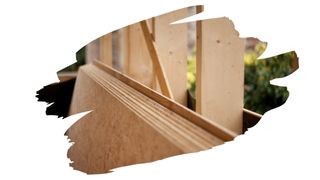Concrete is a notoriously porous material that can easily collect moisture. And this is a pretty big problem when it comes to placing plywood atop a concrete floor.
And why does moisture matter when it comes to gluing plywood right onto to concrete? Well, it’s because moisture can cause plywood to decay away…fast.
So, if gluing plywood directly onto concrete isn’t the best idea, what should you do instead?
Well, in this post, you’ll learn why placing plywood directly onto concrete, is a bad idea in general. You will also discover what will happen to plywood if you do.
And keep reading to find out why elastomeric coatings are the best way to glue plywood to concrete flooring.

This post may contain affiliate links to products that we receive a commission for (at no additional cost to you). Learn more here.
Can You Lay Plywood Directly Onto Concrete?
Placing plywood directly onto wet (or even dry) concrete is a good idea.
Plywood may be a manufactured wood, but this material can still succumb to rot all the same. So, placing plywood on wet concrete means that it will soak up a lot of the moisture in concrete. This, in turn, makes plywood damp enough for wood rot bacteria to thrive in it.
And even dry concrete can be a problem. You see, concrete is an incredibly porous material, meaning it has lots of little holes in it. And those holes can collect ground moisture.
So, once again, placing plywood onto dry concrete can mean that plywood wicks up that moisture, and starts to rot.
Is This The Reason Why You Should Never Set Wood In Wet Concrete?
Absolutely. It is also the reason why outdoor fence posts, (that are placed in concrete), quickly rot away too.
Related Post: What’s The Best Way To Set A Pressure Treated Wood Post In Concrete?
The problem simply lies with moisture. Once that moisture starts to soak up into the wood fibers of plywood, those damp conditions encourage rot and decay.
What’s more, plywood that is perpetually saturated with water, can begin to delaminate.
Delamination is what happens when the glue holding plies together starts to break down. Basically, the adhesive fails, causing those thin plies to slip apart.
And only the most expensive exterior graded plywood, (such as marine plywood), can really handle that level of water saturation.
Related Post: What Is The Best Plywood For Outdoor Use? (Solved!)
So How To You Attach Plywood To A Concrete Slab (Without Drilling)?
Your best option here is to use a moisture-resistant adhesive that can also double as a ‘sealant’ for concrete.
By sealing over concrete, you create a waterproof-barrier preventing moisture from wicking up into plywood. And if that sealant has adhesive qualities, then that’s even better, because it will hold plywood steadfast in place.
Now, when it comes to concrete specifically, the coating you use also needs to be able to stretch and move. This is because concrete can shift around for a range of different reasons, (ground soil, seasonal weather, carbonation, etc).
Which is why you should place a moisture-resistant ‘Elastomeric Coating’ adhesive between plywood and concrete.
What On Earth Are Elastomeric Coatings!?
Elastomeric coatings are stretchy waterproofing barriers. In the case of most building construction, these coatings come as a very thick paint or floor adhesive. And they are applied onto interior or external walls, roofing, or subflooring.
Now, the key benefit of elastomeric coatings is their flexibility. These coatings can stretch to over twice their length, and return back to their original size, without losing their shape.
And it is this adaptable stretchability that makes elastomeric coating adhesives the go-to option for covering concrete floors. Between their waterproofing and flexibility, they are even great at preventing concrete carbonation — which can sometimes lead to concrete cracking.
What Is Concrete Carbonation? Concrete contains something called calcium hydroxide. When carbon dioxide (which floats around in the air) reacts with calcium hydroxide, carbonation can occur. That carbonation reaction is somewhat like the fizzy bubbles you can find in soda.
And What’s The Best Elastomeric Adhesive You Can Use To Glue Plywood To Concrete?
The best one you can use is easily Bostik’s BEST. Bostik’s urethane adhesive is designed specifically for gluing wooden flooring onto porous concrete surfaces.
This adhesive can be used to affix both manufactured wood (like plywood) and solid hardwood subflooring. And it is moisture-resistant, so it will protect plywood from the moisture content in concrete.
Bostik’s BEST also contains their Blockade Antimicrobial Protection. And what this does is prevent mildew and mold from growing on this urethane adhesive. So, it can handle humid environments too.
You can learn more about Bostik’s BEST over on their official website right here.
Great! Can I Go Ahead And Get Started Straight Away?
If you’ve given plywood time to acclimate well beforehand, then go right ahead. The acclimation process involves leaving plywood in the room, (that you plan on installing it in), for a few days.
This allows plywood to acclimate to the room and reduces the moisture content in that plywood. And, most importantly, it reduces the chances of plywood shifting around after installation.
Allowing wooden panels to acclimate first is key when installing any type of manufactured or natural wooden flooring. You can learn more about it by checking out our post: Do New Hardwood Floors Need To Settle? (Explained!)
To Wrap Up, Here Are The 3 Key Takeaways From This Post…
- 1). If you place plywood directly onto wet concrete, it will soak up the moisture in concrete. This can cause plywood to rot.
- 2). Even placing plywood directly onto dry concrete is a problem. Concretes porous texture can collect ground moisture. And that moisture, in turn, can become soaked up by plywood.
- 3). Glue plywood to concrete by using an elastomeric adhesive. And elastomeric adhesive will act as a flexible moisture-resistant barrier between plywood and concrete.
References:
Fallon, Chanel, and Graham J. McShane. “Impact damage protection mechanisms for elastomer-coated concrete.” International Journal of Protective Structures 12.3 (2021): 377-395.



